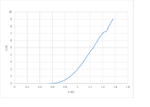will_fung
Junior Member level 1
I measured the V-I characteristic curve of parasitic diode on MOSFET, seems the slope isn't steep like a diode.
I just use a power supply to power the diode, increase the voltage of power supply, and measure the drop voltage and current flow the diode, then i get the V-I curve.
here is my measurement of V-I curve with a parasitic diode on MOSFET. Is my measurement correct? what's the differences between a diode and a parasitic diode on the V-I curve?

I just use a power supply to power the diode, increase the voltage of power supply, and measure the drop voltage and current flow the diode, then i get the V-I curve.
here is my measurement of V-I curve with a parasitic diode on MOSFET. Is my measurement correct? what's the differences between a diode and a parasitic diode on the V-I curve?
